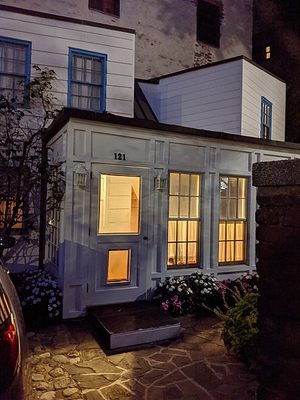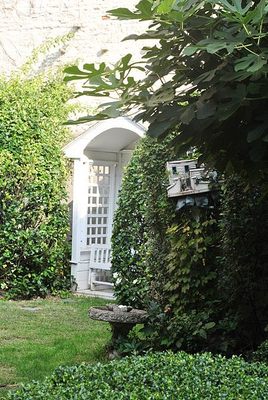About
The little wood-framed house and its idyllic garden look out of place in the Greenwich Village neighborhood of Manhattan. With lots of fascinating corners and angles, the two-story building is dwarfed by those surrounding it on Charles Street. It is one of the oldest homes in the Village, but it was not constructed there.
The wee, white-clapboard home began life as a farmhouse on the Upper East Side. It earned the nickname Cobble Court because of the cobblestones that surrounded it and paved its front entrance. Over time, buildings rose around the farmhouse, hiding the diminutive structure from view.
In the 1940s, children’s picture-book author Margaret Wise Brown rented the little house as her private writing studio. In her book, The Hidden House, Brown describes the home: “It was a little house in the middle of a big city. And nobody knew it was there. It had been there for years and years, for over a hundred years, forgotten. And there it stood in a hidden garden in the middle of a big block of skyscrapers."
Crispin’s Crispian, Brown's beloved Kerry blue terrier, lived with her. He and Cobble Court became the inspiration for Mister Dog: The Dog Who Belonged to Himself. Over the next decade, Brown wrote most of her 100 children’s books at Cobble Court, including her perennial bestsellers, The Runaway Bunny and Goodnight Moon. The fireplace pictured in Goodnight Moon is said to be the Cobble Court fireplace.
Brown used the house as her private studio until her death from an embolism in 1952. In the 1960s, the Roman Catholic Archdiocese of New York purchased the property. The Church intended to demolish Cobble Court to make room for the construction of a nursing home. Sven and Ingrid Bernhard, the house’s tenants, went to court and offered to vacate the property provided they could take Cobble Court with them. The court and the Church agreed. Accordingly, on March 5, 1967, Cobble Court was placed on a flatbed truck and transported down Manhattan to 121 Charles Street in Greenwich Village.
The Bernhards continued living there until 1986. They added an extra-wide gate to the property’s garden entrance so that passersby could easily see and enjoy the house. It is still a private residence to this day. Cobble Court survived a second demolition scare in 2014, and it remains under the watchful eyes of the Greenwich Village Society for Historic Preservation. It will always be associated with its most famous occupant and affectionately known as “The Goodnight Moon House.”
Related Tags
Published
October 2, 2020
Sources
- https://gvshp.org/blog/2018/07/20/one-small-step-for-man-one-giant-leap-for-121-charles-street/#:~:text=One%20Giant%20Leap%20for%20121%20Charles%20Street!,-Matthew%20MorowitzPosted&text=Two%20years%20prior%20though%2C%20the,location%20at%20121%20Charles%20Street.
- https://www.nypl.org/blog/2008/10/02/literary-landmarks-village-goodnight-moon
- https://www.nytimes.com/2008/10/30/garden/30charles.html
- https://www.nyclgbtsites.org/site/margaret-wise-brown-writing-studio/
- https://www.literarymanhattan.org/place/cobble-court/
- http://hatchingcatnyc.com/2016/11/25/crispins-crispian-terrier-nyc-lenox-hill-part-ii/
- https://www.nydailynews.com/life-style/real-estate/old-greenwich-village-farmhouse-razed-condos-article-1.1867709

























